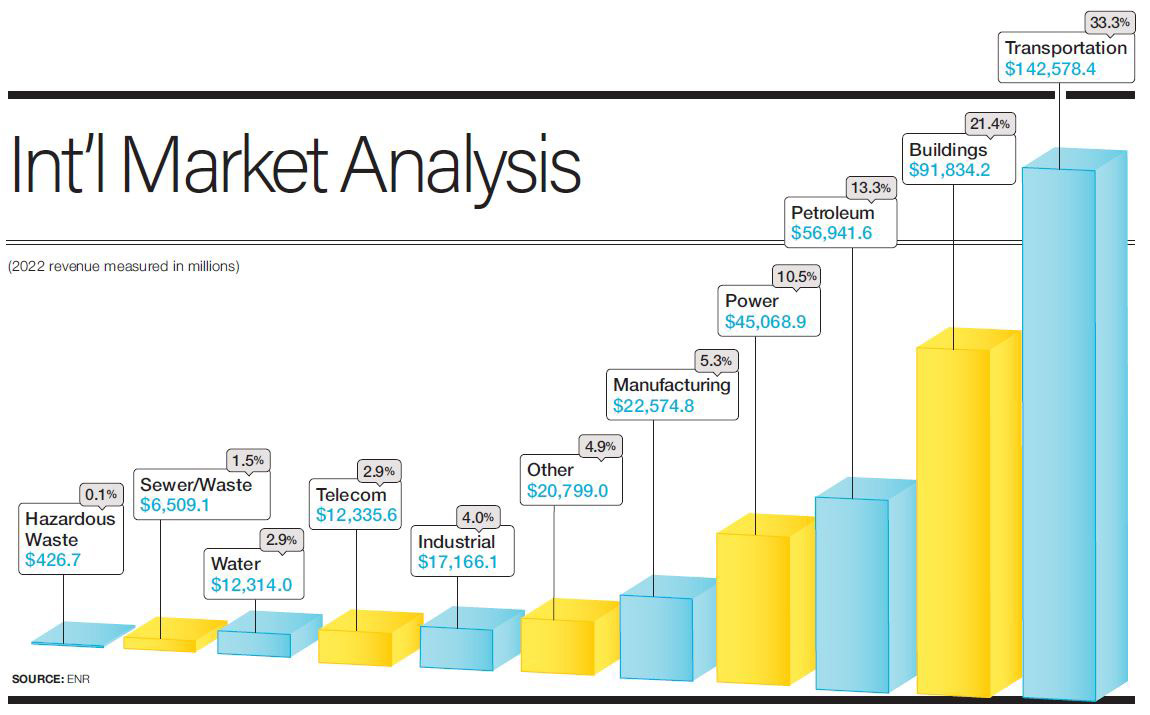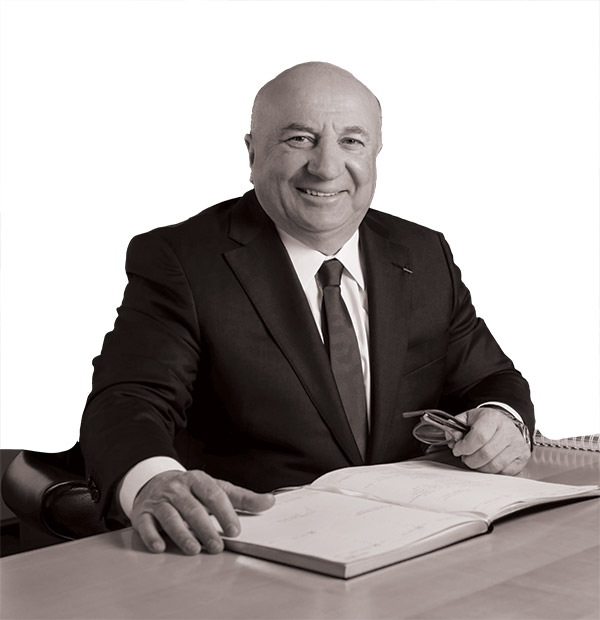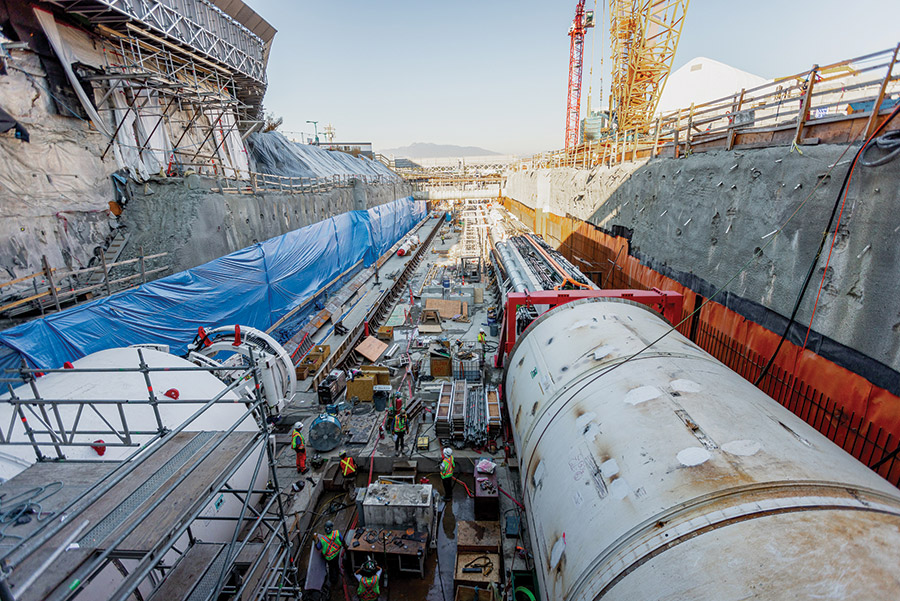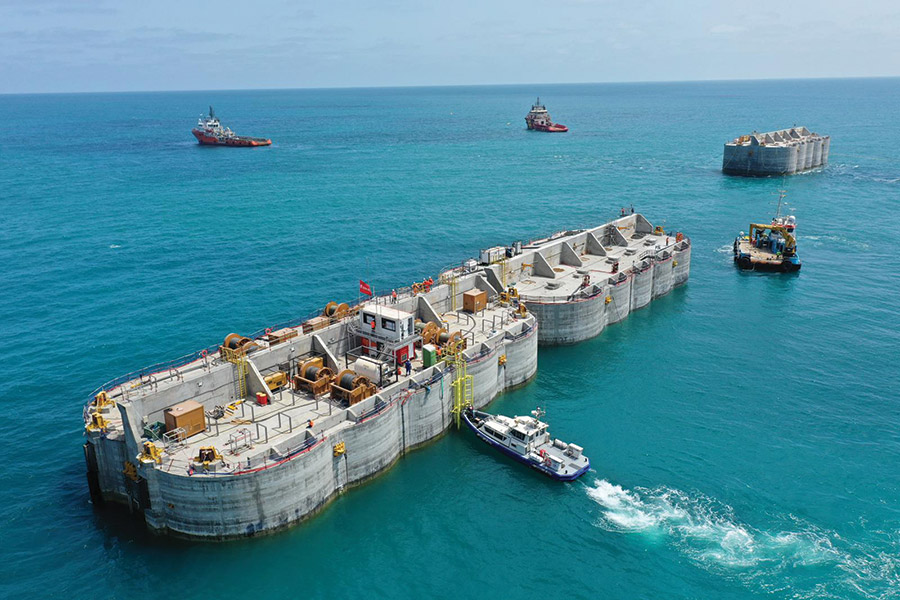ENR 2023 Top 250 International Contractors: Firms Face Big Picture Challenges
August 23, 2023
ENR 2023 Top 250 International Contractors: Firms Face Big Picture Challenges
August 23, 2023Sembol (No. 206) is working on the Nickelodeon Resort and Family Entertainment Center in Antalya, Turkey. The $110-million project, with over 60,000 sq m of construction, is due to be completed in just 11 months
Photo courtesy of Sembol
Success appears to be an art and not a science for this year’s Top 250 International Contractors as their non-domestic revenue rose 7.7% to $428.5 billion in 2022—despite a challenging storm of inflation, skilled labor shortages and supply chain gaps. Amid severe winds of change, firms say backlogs are steady thanks to relationships they have cultivated overseas. But will rising project costs blow it all away?
Combined revenue for the ENR’s 2023 leading 250 international firms marks the largest reported one-year list revenue hike since a 12.3% increase from 2011 to 2012. Of 237 firms also listed on last year’s list, 65% report that revenue was up.
Related Links:
ENR 2023 Top 250 International Contractors
ENR 2023 Top 250 Global Contractors
View complete 2023 list, with full market analysis
(Subscription Required)
The value of new contracts rose as well, up 7.3% for contractors overall from last year, with 53.7% indicating higher backlog compared to just 50.2% of the 2022 list. Median contracting revenue is up 7.5% to $470.82 million, and of 155 firms that reported profits, 91% noted positive returns from international work, a marginal increase from last year.
The top 10 firms share of total international revenue rose slightly from last year, coming in at 43.5% of the total. Included are France-based Vinci, ranked No. 1 at $35.7 billion in international revenue; Grupo ACS/Hochtief, ranked No. 2 at $34.1 billion; and China Communications Construction Group Ltd., ranked No. 3 at $23.5 billion.
In comments, firms shared divergent views and strategies on how best to make and maintain inroads in international contracting markets, with a trusted reputation and strong local relationships emerging as their key indicators of success. In a market plagued by uncertainty, having established local relationships abroad can be a competitive edge, says M. Engin Günindi, director of business development at FEKA İnşaat ve Sanayi Ticaret A.Ş.
He explains that building a trusted reputation in contracting often starts at home. “A picture is worth 1,000 words,” says Günindi, adding that “the most important driving factor” of the contractor’s global success has been the performance of the company itself.
“We know that providing solutions that ensure the functionality of the project without compromising quality or technical requirements, and striving to achieve the utmost effort within contract boundaries to satisfy our clients is the best response we can give to the question, ‘Why FEKA?’” he says.
In the global contracting market, patience and preparedness “are key,” Günindi adds. To achieve this, contractors must balance a high-level understanding of broad market challenges and strong local knowledge that builds an ability to advance projects and avoid delays on the ground.
“Conducting preliminary research and studies to familiarize ourselves with the target country or region, along with the involvement of local partners, is crucial,” he says.

Driving Success
What works in one market for a contractor, however, may not work for others, or a firm may find use of a strategy unsuccessful in a new market. Every market can have its own unique entrance parameters, explains Waleed Lotfy, Petrojet chairman and managing director. The Egypt-based company is ranked No. 140 in 2023.
In deciding to enter new markets, the key to success is being very selective, “as we need to bring our A-game” to build trust with clients and communities, he explains.
“In-depth market study is definitely key in realizing a sustainable and profitable presence in any new market,” says Lofty, which can include a study of local laws and regulations.
According to Ant Yapi Industry & Trade Inc. executive board member Mehmet Okay, the Istanbul-based contractor will stick to its strengths in the four regions in which it operates—Turkey, Russia, the U.K. and U.S. “Our business partners and team trusted us,” he says. “In a nutshell, we owe our success to our sense of responsibility.”
As a leading infrastructure developer in Latin America, contractor Sacyr has cultivated a track record of winning international projects due to a number of factors, according to José Manuel Loureda López, the company’s business development general manager.
In addition to assessing its own financial capacity and risk analysis, he cites careful project selection, varied contract risk allocation structures and “occasional partnerships with local or international companies.”
TAV Construction’s accumulated experience and successful track record in all types of airport construction projects have added to its ability to take on international projects. The Istanbul-based company is ranked at No. 114.
“Our people are flexible and determined,” emphasizes TAV Chairman M. Sani Şener. “In today’s world you can transfer capital, goods and know-how between geographies, but you can’t transfer culture. You can only integrate cultures, and this is crucial for success in business.”
Cross-border Factors
Success at cultural integration has enabled TAV to transfer its airport business expertise to different regions. The longevity of market presence for some companies abroad can also drive their expansion “due to the availability of extensive business contacts, availability of a client portfolio and adaptation to different environments,” says Uzi Sezer, general coordinator of utilities and water solutions for Malta-based contractor ERG International Group.
Additionally, an ability to secure large loans from financial institutions at low interest rates to finance international projects has become key in global construction, he says, boosted by a trusted reputation among lenders.
“The international contracting market has been growing for the last two decades and technology, rapid communication and transport, integrated markets and commercial liberalization have fueled this expansion,” says Sezer. “All international contractors have to adapt certain abilities to be successful in this market and to be able to overcome the difficulties of working in a foreign country.”
Challenges and Trends
Top 250 firms pointed to a mixed bag of global challenges affecting their respective markets—including supply chain disruptions, skills shortages, economic instability, the energy transition, climate change concerns and the war in Ukraine. Yet for many listed companies, a readiness to adapt to such challenges requires a willingness to change and embrace innovation.
“It’s important for construction companies to stay informed about these issues and trends, adapt to changing circumstances and embrace opportunities for innovation, sustainability, and efficient project delivery,” says Jalal Chaarawi, business development manager of Combined Group Contracting Co. “Proactive management of risks, continuous learning and strategic planning are crucial in navigating the positive and negative factors” impacting the global construction industry.

“In today's world, you can transfer capital, goods and know-how between geographies, but you
can’t transfer culture.”
M. Sani Şener, Chairman, TAV Construction
Among Top 250 list market segments, the largest 2022 revenue increases were seen in telecom, up 65.5% to $12.3 billion; hazardous waste, up 16.7% to $426.7 million; and industrial, up 13.3% to $17.17 billion. Sewer/waste, at $6.51 billion, was the only market to decline.
While the top 10 telecom contractors saw the largest gains, the market’s growth is also a product of more firms entering the market. In 2022, 26 firms had at least $5 million in telecom revenue, but that rose to 39 in 2023. The Top 10 share of telecom revenue fell to 89.7% from 92.6% last year.
Ranked at No. 6 in that sector, Skanska says its operations in central Europe have been impacted to an extent by the continuing war in Ukraine. The company has ceased operation there, but is still working in neighboring Poland.
Ukraine-related upheavals have only compounded growing inflation and supply chain challenges that began with the COVID-19 pandemic, says Sacyr’s López. “Some administrations and clients have not acknowledged this increase in costs or have taken too long to do it, which has taken a toll in sector activity and is an issue that must be addressed,” he says.
The rising cost of raw materials continue to be an issue affecting international and domestic markets for global contracting firms, says COMSA Corp.’s Guillermo Lorenzo, CEO of infrastructure, engineering and services.
As such, the “definition of compensation methods by the different agents involved in the construction sector is key in the development of projects,” he explains. Additionally, political changes and stability of currencies are also “very influential subjects for enabling an adequate forecasting, prediction and evaluation method.”
With the international construction sector being one in which projects with significant financial and social impacts are realized, FEKA’s Günindi adds that regional projects are also “highly sensitive to changes in social and economic life,” as well as to global and geopolitical balance challenges.
“However, as exemplified by the increasing dialogue between Israel and Arab states in the region, contributing to a moderate climate prevailing in the Middle East, geopolitical factors are also on the list of trends positively affecting the industry,” says Günindi. “Despite mentioning the negative aspects first, it is essential to emphasize that the industry generally has a positive outlook for the future. The resurgence of large-scale international investments to compensate for time lost during the pandemic is the most significant motivating force in the sector.”
Mass Transit and Rail | By Jonathan Keller
Broadway Team Forges a Link in Vancouver

Photo courtesy of Acciona
With an estimated 100,000 trips daily, the Broadway B-line bus corridor in Vancouver, British Columbia, is one of the busiest in North America. The $2.8-billion CAD Broadway subway project, announced in 2018, aims to deal with corridor congestion and improve travel time. A consortium of Acciona (No. 20) andGhella (No. 88) is building the line, in a 60/40 split.
The team began with demolition and building traffic decks above the six future subway stations. Jeff Spruston, project co-representative for Broadway Subway Project Corp., called the process ”surgical,” since the line had to remain open for through traffic and for about 500,000 daily pedestrian crossings. “You can imagine a very small machine digging a fairly large excavation and that material has to move all the way to the end of the block to get loaded out,” he says. “So, it was painful.” Excavation required chewing through dense glacial till. “It’s very hard—almost a sandstone in areas we’re digging,” says Spruston. Till typically must be ripped before it can be dug, and after 15 to 18 m, the team hits bedrock, he adds.
To build traffic decks, crews drilled vertical columns on both sides of the street. Traffic was closed on one side to allow excavation and installation of a girder to the centerline of the street, along with a temporary precast footing. Traffic was then diverted to the partly finished deck, allowing for a repeat of the process on the other side—with a bolted connection in the center. It averaged six months to build the typically block-long decks.
Drilling the twin tunnels between stations falls to two tunnel boring machines, each 150 m long with 6 m dia. At their peak, the TBMs have churned through 50 m in a day, but Spruston stresses steady progress. He says, “50 meters in a day is fun. But as project manager, we're more interested in what we can achieve over a week or a month, not how fast we can sprint.” The machines have averaged 18 to 20 meters per day, with their work about 40% done as of ENR press time.
Around 125,000 people live in the corridor, with some residences edging the excavation, requiring the team to build cantilever catwalks for building access. In one case workers had to cut slots into a building parkade. The project has tried to be a good neighbor, affirms Spruston. Acciona says its team has had more than 14,000 community interactions since fall 2020.
The project team, which has also sought to diversify its workforce, is set to meet or exceed employment targets for members of the Musqueam, Squamish and Tsleil-Waututh Indigenous Nations. As of June, the project workforce was about 17% women. Project TBMs are named for Elsie MacGill, a Vancouver native and first woman admitted to the University of Toronto engineering program, earning a master’s in aeronautical engineering in 1929; and Phyllis Munday, a long-time city resident and woman mountaineering pioneer who summitted more than 100 peaks before her death in 1990.
IBI Group is designer on the line's four inner stations, with Dialog handling the end stations and Parsons handling the systems design. The 5.7-km-long line will include 700 m of elevated guideway, linking to the existing Millenium Line, as well as 21 piers and 106 conventional precast girders.
Once finished, the line is expected to move nearly three times more people than the current B-line. It is scheduled to open in 2026.
Carbon Cutting
Global decarbonization is a major geopolitical trend that is driving forward environmental regulations, use of eco-friendly materials and green building practices, says Ramez Al-Khayyat, president of Qatar-based UrbaCon Trading & Contracting Co.
“There are so many trends that are affecting international construction in a positive way,” adds Al-Khayyat, emphasizing that “adopting modern technology and including it in the construction industry” will enhance project efficiency, reduce costs and improve safety.
Offsite modular construction and prefabrication also are gaining popularity by “speeding up project timelines and minimizing on-site disruptions,” he says. “We are also excited to integrate modular construction into [the company]. This model of construction helps us become more efficient, sustainable and cost effective.”
In Saudi Arabia, UrbaCon is working on three key entertainment complex projects in Medina, Tabuk and Yanbu. Ranked at No. 155, the Qatar-based firm has also added an energy and utility division, in addition to the construction and operation of power stations in Libya.
“We have already expanded our projects portfolio to promising regional and international markets, such as Saudi Arabia, Algeria, Iraq, Egypt and other countries,” says Al-Khayyat. “This expansion will enable us to tap into new markets, offer our services to a broader audience and increase our revenue.”
Geographic Opportunities
Big ticket infrastructure spending packages and expansion plans such as the 2021 infrastructure investment law and 2022 Inflation Reduction Act, both in the U.S.; Saudi Arabia’s Vision 2030; and Africa’s Agenda 2063, among others, are helping to draw firms to regional hot spots for resource investments.
Lorenzo of COMSA says the company believes the “most interesting opportunities” for the global construction sector are in Europe, “mainly in the Balkans and the Nordic countries, territories that have been developing ambitious infrastructure plans for some time.” He also mentions Portugal’s growing infrastructure investment plans and the Rail Baltica transit megaproject that will link Finland, Estonia, Latvia and Lithuania with Poland. Considered a “priority project” for the European Union, it is set to have 870 km of track, three multimodal terminals and sea and airport links in the region.
“Latin America is also an attractive market despite its economic and political instability,” says Lorenzo. “Countries such as Brazil, Mexico or Colombia have interesting infrastructure development plans.”
Trevi Group CEO Giuseppe Caselli explains that the company only recently came under ownership of CDP Equity, a long-term investor in strategic sectors that is 100% owned by Italy’s Cassa Depositi e Prestiti and U.S.-based investment adviser Polaris Capital Management.
But the contractor has been involved in projects on five continents for many years. “We have been present in Latin America and Africa since the 1970s, but in such regions, our business strategy includes the presence of the group only in a few countries where we are involved in major projects, both infrastructure and private ones,” says Caselli.

“We see a very healthy pipeline of capital project opportunities in the Middle East as it benefits from significant infrastructure investment.”
Jennifer Richmond, Executive President, Wood
Petrojet Chairman Lotfy says Africa presents the most potential but also the biggest challenges for construction projects. He points to the “lack of finance and proper infrastructure, in addition to increased material prices.”
For Sacyr, English-speaking markets offer the company the most attractive opportunities through public-private partnership infrastructure arrangements, according to López, because the project delivery format allows for development of “the project on time and with the best possible quality,” he says. “Our greatest challenge is to fully consolidate our P3 business activity in English-speaking markets, where our presence is currently relatively small, but it will be one of the company’s core pillars in the medium term.”
Manuel Olivares, bidding and commercial director of Spain-based contractor FCC, names Pennsylvania’s Major Bridge P3 Program and transportation development in Toronto, Ontario, among the company’s representative construction market opportunities in the U.S. and Canada, among others in Europe and the Middle East.
“Every project from the moment of the study is subjected to a rigorous evaluation and legal, financial, economic, and technical risk control,” says Olivares. He touts the progressive design-build construction project delivery approach among the benefits of the company’s work in North America.
“This model includes the opportunity to refine design, optimize schedule, reduce risk, and finalize pricing before construction,” Olivares points out.
Alternatively in Saudi Arabia, he says the company is involved in projects that are located in remote desert locations far from cities. “There is almost no infrastructure in the area, and it is necessary to set up camps to accommodate the many workers needed to carry out the work,” he explains.
At Wood, “we see a very healthy pipeline of capital project opportunities in the Middle East as it benefits from significant infrastructure investment by governments,” says Jennifer Richmond, the contractor’s executive president of growth and development. The company is ranked at No. 41.
She adds that there is also opportunity in countries where governments are investing in energy transition-related infrastructure development.
“In the U.S., the introduction of the [Inflation Reduction Act] was a bold move by the Biden administration to drive growth and investment in increasingly challenging economic conditions,” Richmond contends. The law “is undoubtedly widening the opportunity pipeline and market attractiveness … in delivery of energy transition projects.”
LNG | By Jonathan Keller
Eiffage Wades Offshore to Deliver LNG

Photo courtesy of Eiffage
Eiffage (No. 14), along with its consortium partner Saipem, are EPCI contractors on the floating LNG terminal facility portion of the Greater Tortue Ahmeyim project. Located 10 km off the African coast between Senegal and Mauritania, the platform contains more than 3,000 tonnes of steel. Eiffage reports more than 60% of the offshore workers are local employees.
Building Relationships and Safeguards
For many Top 250 companies, the importance of local partnerships is evident when navigating skilled labor shortages.
“Partnerships work best when the values of the project partners align,” says Jacob Birkeland, head of media relations and public affairs at Skanska. Noting the contractor’s work on London’s HS2 high-speed rail tunnels under its Skanska Costain STRABAG joint venture, he says the team’s shared values have supported the delivery of the project and shaped its culture.
“The team is made up of people drawn from the U.K. and overseas,” he explains. “All business decisions should be aligned with these values.” This includes an understanding of risk-sharing and an agreement on how to mitigate labor-related risks through safety protocols.
Last year, Sicim Managing Director Guido Cagnani says the contractor invested in approximately 868,000 hours of training activities, “most of which were in health, safety and environment training.” He says the company considers health and safety “of primary importance” in the continuous improvement of working conditions.
Dorçe general manager Doruk CoŞkunsu says the company’s top priorities are minimizing risk, enhancing productivity and improving its business opportunities through environmental and quality management.
“Construction safety is still in progress in developing countries, and there are some unique challenges in implementing effective safety programs and practices,” Coskunsu points out. “Therefore, Dorçe shares its global experience and implements international standards.”
To keep its labor teams safe in all global construction locations, FEKA says its initial requirement is to adhere to international standards led by organizations such as the International Labor Organization and the U.S. Occupational Safety and Health Administration.
“Additionally, we seek guidance from local experts and specialized firms to effectively apply not only the additional conditions defined in the contracts, but also other aspects stipulated in the local laws of each country where we operate,” says Günindi. “The most valuable asset for a construction company is a capable workforce that is working in harmony,” he adds, a universal idea that applies to any location.











